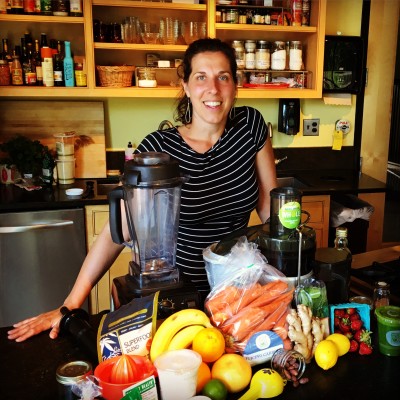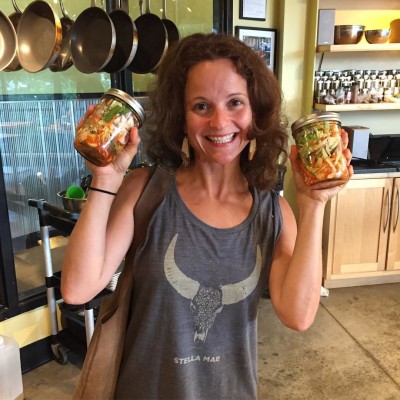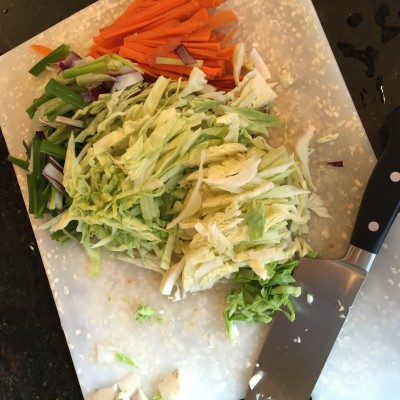Fermented Foods with Gaby Goldberg


Fermented food has regained popularity over past years. I’m not sure it went out of style in Vermont considering the history of homesteading. Growing up, I watched my eastern European mother process fresh picked fruits and veggies, leave kefir, kombucha, and kvass on the counter to bubble and fizz, and hunt mushrooms spring through fall. To my dismay, my mother tried to feed me her nutrient and enzyme rich creations. As I got older, I began to have a taste for her sauerkraut and the occasional wild mushroom dish. I was still appalled that she would leave milk out on the counter to ferment and then drank what would later become kefir – pronounced “Ke-fear” in Europe, not “Kee-fir” as you may know it as.
Fast forward to my early twenties when I began to practice yoga and spent time volunteering in yoga centers and ashrams. Here I adopted a vegetarian lifestyle and learned how the practice of yoga integrates food – how we eat and prepare it – into daily living and a spiritual practice. I now see that I had relearned everything my mother had been showing me my entire life. Though I no longer subscribe to vegetarianism alone, I do integrate yogic values and philosophies into how I prepare food and eat which is an overall healthy approach that works for me. My intent of eating healthy and well eventually led me to discover my love for all things fermented or “cultured”.
There are a few reasons I got into eating fermented foods. It started with Kombucha. After yoga, I love to drink a Synergy Trilogy, especially before the entire FDA debacle when the fizz and culture of the drink was so alive! The FDA took my favorite to-go drink off the shelves because there was a lack of alcohol rating on the label. As a young entry-level professional in Burlington…I also was spending anywhere between $4-$25 a week on Synergy drinks. So I decided it was time to brew my own kombucha. I found a recipe, a scoby, and had a brewing consultation call with my mother of course! I still purchased various kefirs at the farmer’s markets and health food stores…I wasn’t ready for that yet.
Fermented foods are good for your gut. The reality of many of our modern day diets is that there are a lot of preservatives and processed foods that literally stop things up and make it hard to absorb nutrients into the body. Fermented foods contain good bacteria that help your micro-biome, or internal ecosystem of the GI tract, stay active and healthy. The good bacteria grows and colonizes in your cultured foods and when you ingest it, there are a number of process that occur but what I notice most, is that I feel my body’s natural rhythm kick up a notch – or a few if I am ingesting all three foods from the fermentation trilogy!

The three foods of the fermentation trilogy are veggies, kombucha, and kefir. You might recognize the veggies as kimchi, sauerkraut, or any combo of lacto fermented vegetable. Until recently, I had always consumed one or two of the three, but not all three together. When I decided to try all three daily, there was a massive shift in how I felt. Initially, I didn’t feel good…My gastrointestinal tract needed to be cleansed after a long winter of job juggling, eating when I could and whatever I had access too, and high stress paired with poor sleep. Let’s just say I had a good cleanse and my level of energy increased immensely after the first two days of integration. I recommend learning how to create the fermentation trilogy in your own home because:
1. It saves money
2. It’s great for you and your family’s health
3. Immunity boosting
4. An easy way to make healthy food choices
Ease into integrating the fermentation trilogy into your diet. Your home creations tend to be the most wild and potent, feeding off good bacteria from your local organic produce and the air in your home. That means your cultured food might be healthier for you than some of the brands you buy! Start with an ounce of each a day and watch how your body responds. Increase from there – You can really feel the foods effect from mouth to stomach and the whole GI tract!
“Wild fermentation is a way of incorporating the wild into your body, becoming one with the natural world. Wild foods, microbial cultures included, possess a great, unmediated life force, which can help us adapt to shifting conditions and lower our susceptibility to disease. These microorganisms are everywhere, and the techniques for fermenting with them are simple and flexible.
Wild fermentation involves creating conditions in which naturally occurring organisms thrive and proliferate. Fermentation can be low-tech. These are ancient rituals that humans have been performing for many generations. They are a powerful connection to the magic of the natural world, and to our ancestors, whose clever observations enable us to enjoy the benefits of these transformations.” SANDOR KATZ
Make your own basic (Americanized) kimchi.
¼ – ½ lb napa cabbage or any cabbage you like
3 scallions
3-4 inches daikon (julienned)
1-2 carrots (julienned)
3 cloves garlic (to taste- add whole and thin sliced)
1-2 inches ginger (to taste)
non-iodized salt* (1-2 tsp per 32oz of veggies)
crushed red pepper or traditional Korean gochugaru* (to taste)
mason jars or flip top lock jars*
*Found in Healthy Living’s bulk spice section
1. Thoroughly wash all vegetables – do not use soaps or disinfectants of any sort. Just cold clean water. Drain and dry gently
2. Prepare veggies how you like them. Traditionally, the cabbage core is removed and cabbage leaves remain whole. Remove any unpleasing leaves or parts from all veggies. Other ingredients are traditionally the size of a match-stick. If you have time, cut and prep veggies mindfully, making pieces neat and uniform. If you know a mantra, chant it to yourself or out loud to infuse your food with positivity and goodness!
3. Make brine with good salt – non iodized and free of anti-caking agents – add it to your jar with good clean water. Add red pepper or gochugaru. Crush or chop the crushed pepper until semi-fine to fine – This creates more of a paste. Water amount is up to you. Salt will pull water out of the cabbage creating more brine later in the brew process, but less overall. If you like a lot of brine, add more water initially. Traditional kimchi is usually made without brine. Do what you like!
4. Gently mix veggies together in a glass or wooden bowl
5. Add veggies to jars, close jars and gently shake/rotate to cover veggies in brine. Open jar and compress veggies down. Leave 1-2cm on top so it’s hard for bacteria to grow. If you have a lot of brine, compress until there’s only brine above the veggies – This protects the veggies from mold and bad bacteria but in all my cultured creations, I have never seen this happen and am diligent about always using clean utensils and glass
6. Leave kimchi out on your counter or traditionally, out of the sunlight somewhere dark. Open the jar once a day to let the gases release. On day 3, start tasting. If you like the taste put it in the fridge and start enjoying. Let your kimchi ferment for 3-5 days
Next batch, add a little brine from your first batch to kickstart the process. Questions as you brew? Contact me at gabygoldberg@gmail.com. Enjoy your kimchi and have fun with integrating this healthy practice into your daily life!
Things you can do with your kimchi:
• On a sandwich, burger, or in a wrap
• On or in a salad
• Side dish for any meal
• Over eggs/on the side/scramble them in
• Quiche
• Kimchi Butter – http://phickle.com/kimchi-butter/
• Kimchi Pancakes – http://phickle.com/weeknight-dinner-kimchi-pancakes/
• Bloody Kim(chi) – http://phickle.com/bloody-kim-the-kimchi-cocktail-at-the-science-festival/
• Salad dressing, aioli, hummus
• Be creative!
Check out resources that helped me determine how I like to ferment food. These links inspire my kitchen projects.
http://phickle.com/kimchi/ More traditional kimchi recipe with Western adaptations
http://nourishedkitchen.com/kimchi-recipe/ Good basic recipe – Sub sugar out with pear, apple, or banana. Note this recipe is for 4 quarts
http://www.culturesforhealth.com/how-to-ferment-vegetables Ideas for fermenting things other than kimchi.
http://www.wildfermentation.com/ Sandor Katz is amazing, check him out!
http://nourishedkitchen.com/recipe-index/ferments-cultured-food/
http://thestonesoup.com/blog/2014/08/the-number-1-way-to-improve-your-gut-health/
Gaby Goldberg is a seeker, an adventurer, and a liver of life. She is located in the heart of northern Vermont where she regularly teaches yoga and plays on the mountain. She leads yoga and surf retreats in Maine and Central America. Gaby thrives on fresh air, connecting with people, and nourishing food. Her yoga classes offer transformative experiences. Join her in learning how all aspects of your daily life can become an act of yoga, including cooking and eating. Gaby often teaches classes in our Learning Center, including two more parts of her Fermentation Trilogy; look for those classes in September and October.



